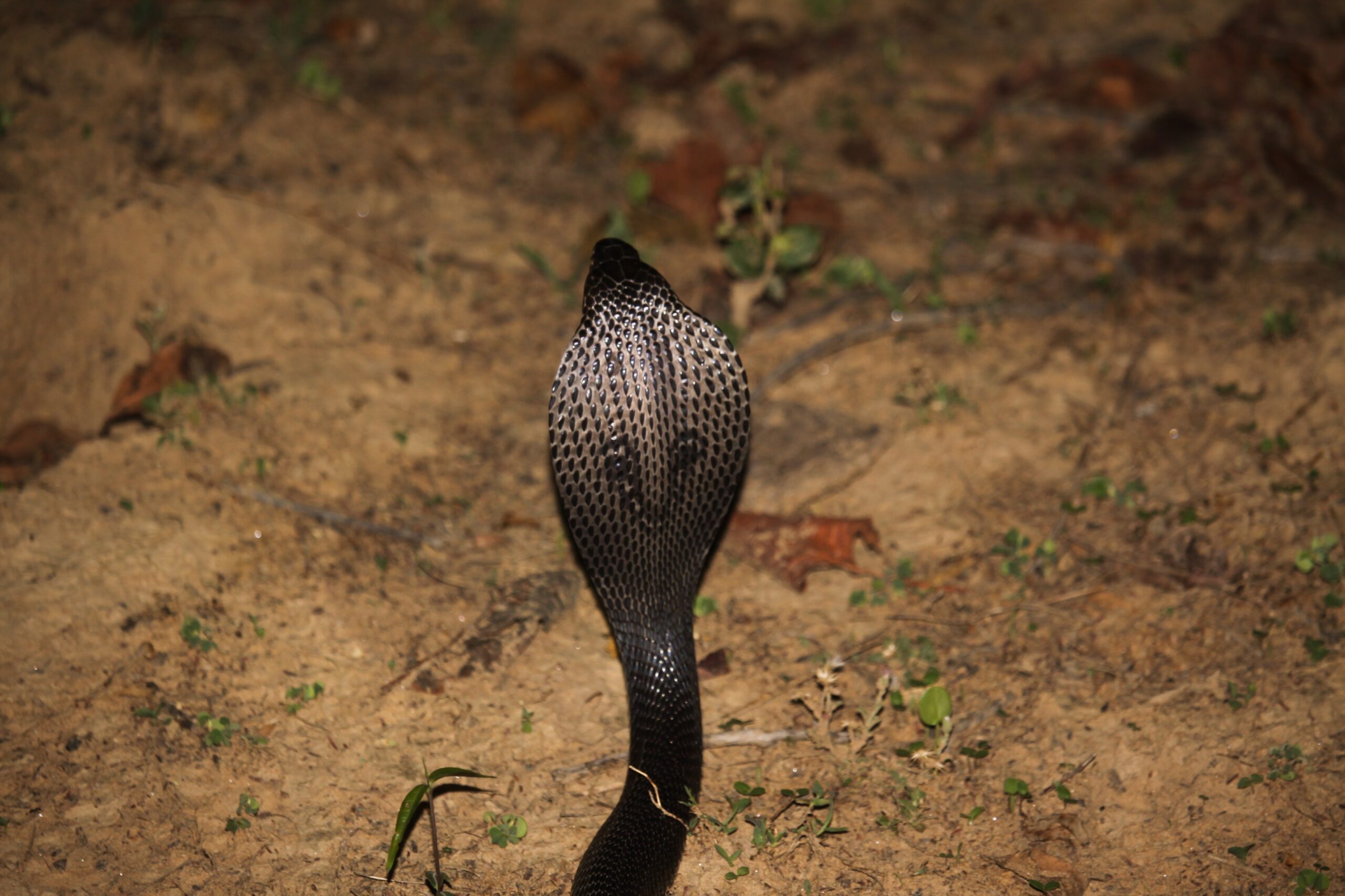Snakes have long captivated human imagination, eliciting a mix of fear, fascination, and admiration. The diverse species of snakes, with their sleek, sinuous bodies and enigmatic behavior often evoke primal instincts deeply ingrained in human psychology. From ancient folklore to modern-day literature and cinema, snakes have been portrayed as symbols of wisdom, transformation, and danger.
In Madhya Pradesh, a state rich in biodiversity, studies have reported a total of 43 species of snakes. This diverse snake fauna includes a variety of venomous and non-venomous species, ranging from the iconic Indian Cobra to the elusive Russell’s Viper.
SPECIES OF SNAKES IN KANHA TIGER RESERVE
Kanha National Park is home to a diverse array of snake species, with Chandra et al. (2008) from the Zoological Survey of India documenting a total of 20 species of snakes. Their study also provided an extensive inventory of 39 reptilian species under 30 genera and 12 families, highlighting seasonal variability in species occurrence. Among the venomous snakes in the park, notable species include the Indian Cobra (Naja naja),and the Common Krait (Bungarus caeruleus), which are known for their neurotoxic venom that affects the respiratory system.
The Viperidae family includes the Green or Bamboo Pit Viper (Trimeresurus gramineus), Russell’s viper (Vipera russelii), and the Saw-scaled Viper (Echis carinatus), all possessing haemotoxic venom that can cause fatal haematuria. Non-venomous species found in the park belong to the Colubridae family, such as the Rat Snake (Ptyas mucosus), Wolf Snake (Lycodon aulicus), and the Vine Snake (Ahaetulla nasuta), which are important for controlling rodent populations and maintaining ecological balance. These species play a crucial role in Kanha’s ecosystem, supporting both predator-prey dynamics and biodiversity conservation.
Top 16 Species Of Snakes In Kanha National Park
1. Russell’s Viper (Daboia russelii)
Common Name: Russell’s Viper
Degree of Venom: Highly venomous
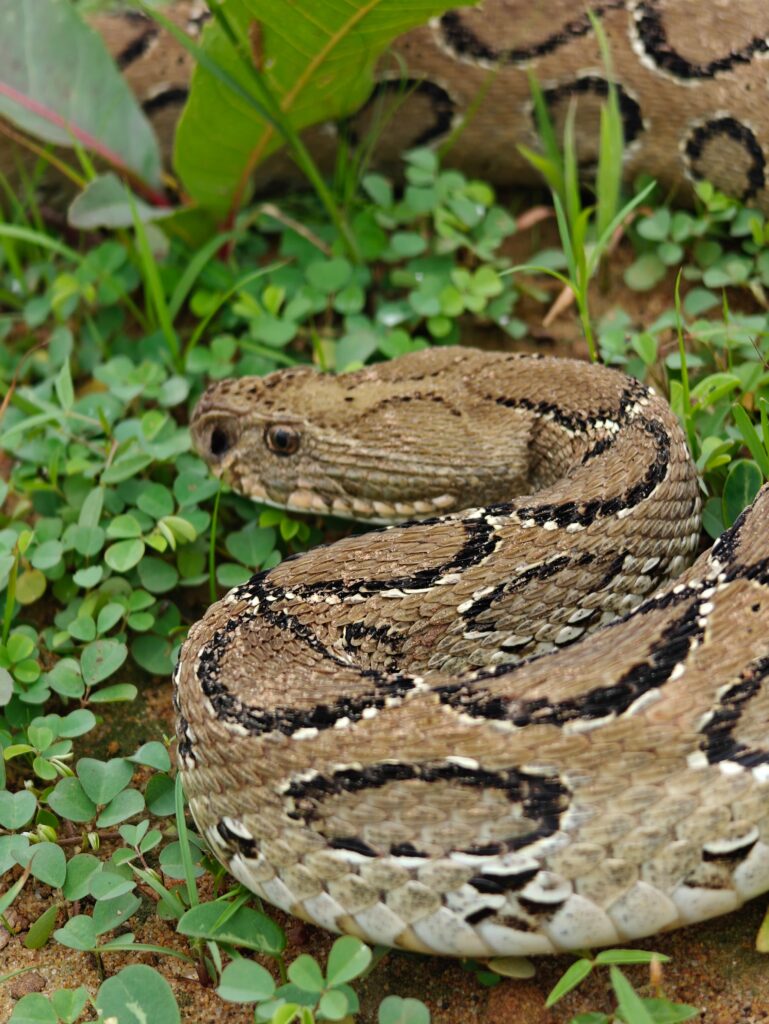
Description: Russell’s Viper is a large and aggressive snake with a triangular-shaped head and a distinct pattern of dark bands on its body. It is responsible for many snakebite fatalities in India due to its potent venom, which can cause severe tissue damage and systemic effects.
Also Know About: Popular Gates of Kanha National Park
2. Common Krait (Bungarus caeruleus)
Common Name: Common Krait
Degree of Venom: Highly venomous
Description: The Common Krait is a highly venomous nocturnal snake characterized by its glossy black color with narrow white bands. Its venom contains neurotoxins, which can lead to paralysis and respiratory failure, often resulting in death if untreated.
3. Saw-scaled Viper (Echis carinatus)
Common Name: Saw-scaled Viper
Degree of Venom: Highly venomous
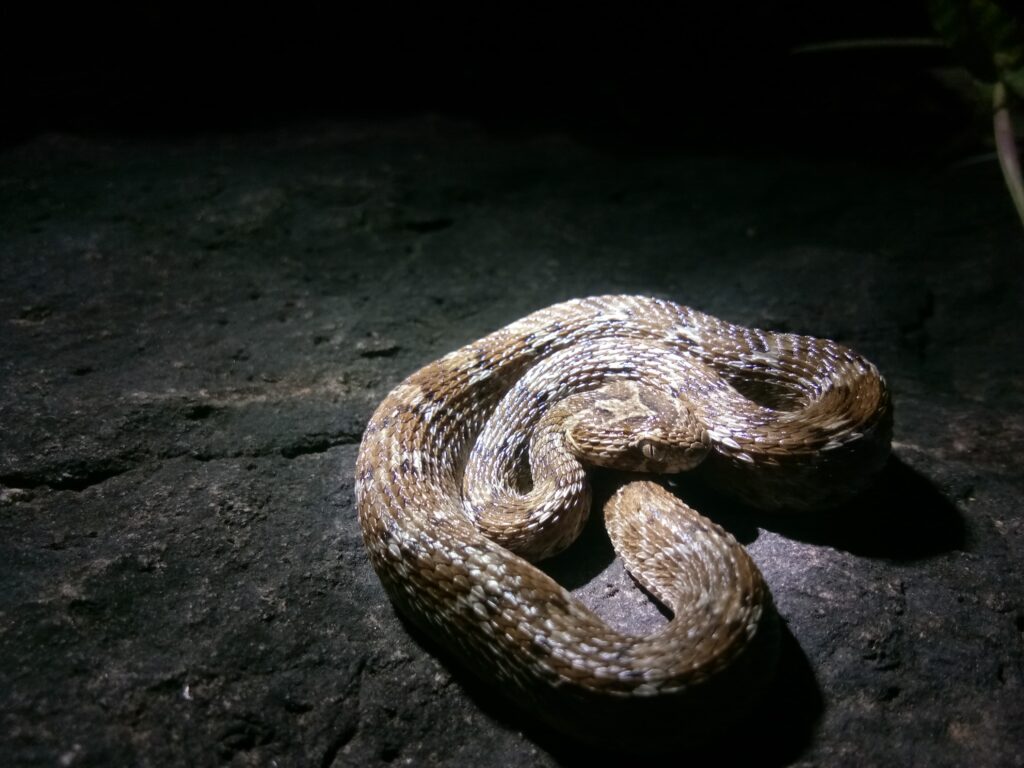
Description: The Saw-scaled Viper is a small but highly venomous snake known for its aggressive behavior and distinctive saw-like scales. It is responsible for many snakebite incidents in rural areas, particularly during agricultural activities.
4. Indian Cobra (Naja naja)
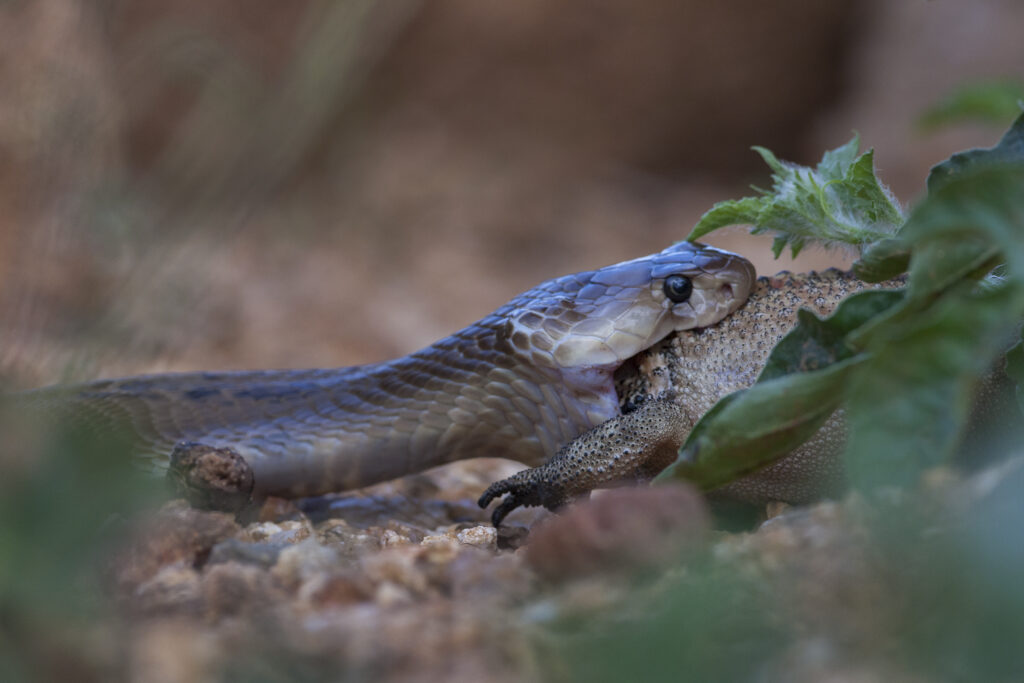
Common Name: Indian Cobra
Degree of Venom: Highly venomous
Description: The Indian Cobra is a venomous snake with a hooded appearance and a prominent spectacle marking on the back of its hood. It is widely distributed across India and is responsible for numerous snakebite incidents.
Also Know About: Best Time to Visit in Kanha National Park
5. Indian Rock Python (Python molurus)
Common Name: Indian Rock Python
Degree of Venom: Non-venomous
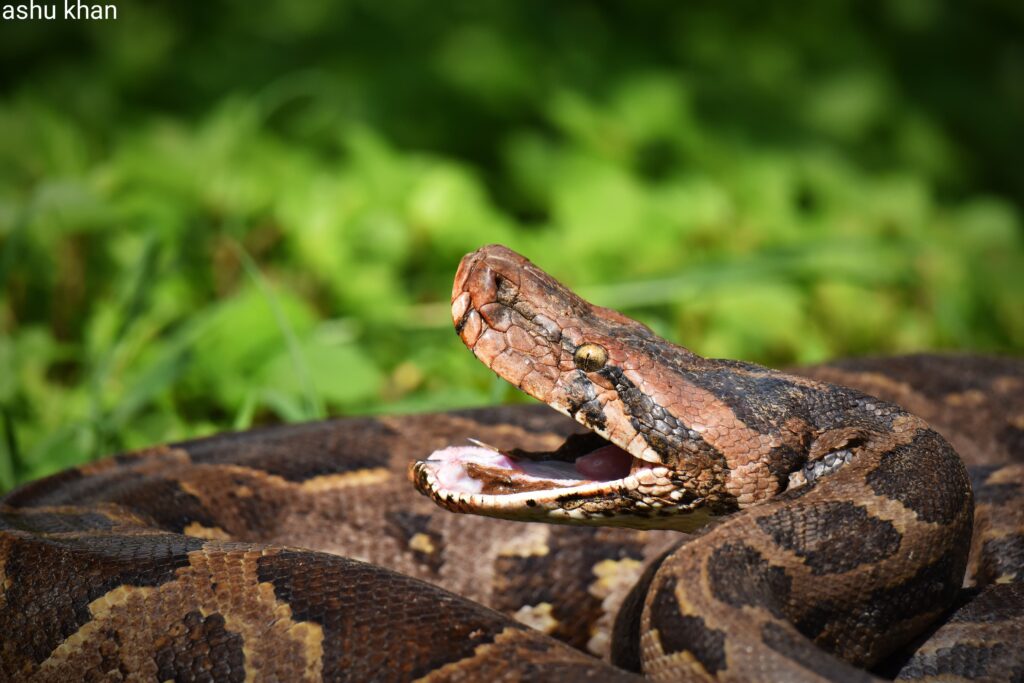
Description: The Indian Rock Python is a large non-venomous constrictor snake found in a variety of habitats, including forests and agricultural areas. It is known for its impressive size and ability to suffocate prey by constriction.
6. Forsten’s Cat Snake (Boiga forsteni)
Common Name: Forsten’s Cat Snake
Degree of Venom: Mildly venomous
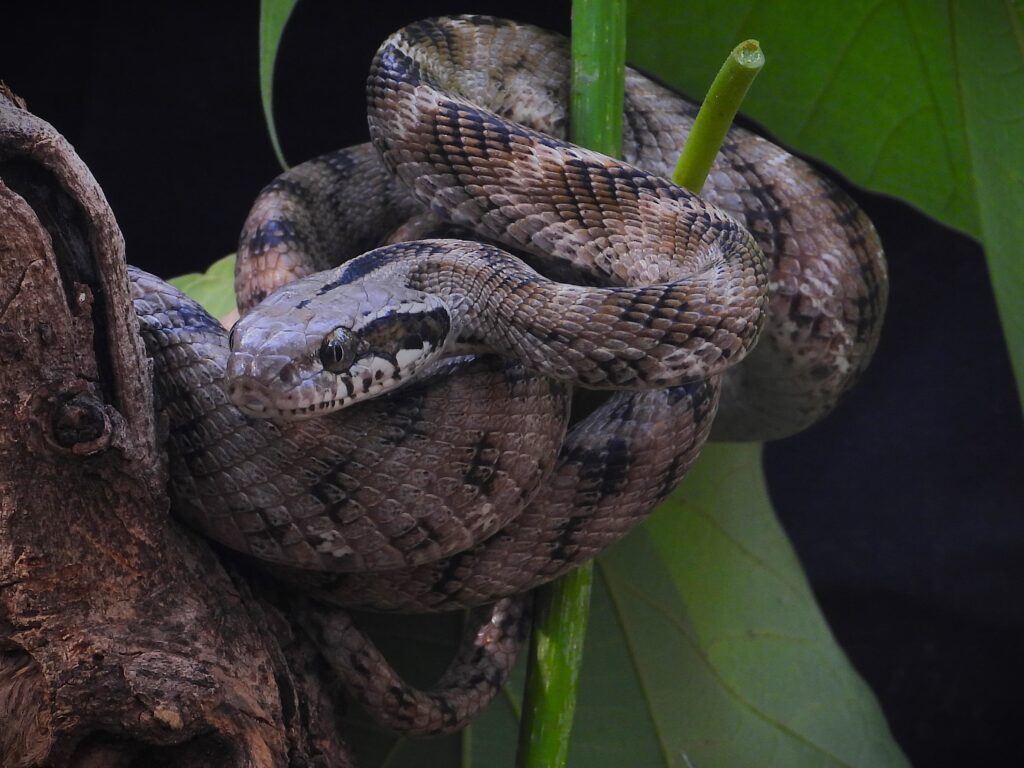
Description: Forsten’s Cat Snake is a slender and agile snake with a pale yellow or brown coloration and dark spots or stripes. Its venom is relatively mild, primarily used to immobilize small prey such as rodents and lizards.
7. Copper-headed Trinket (Coelognathus radiatus)
Common Name: Copper-headed Trinket
Degree of Venom: Mildly venomous
Description: The Copper-headed Trinket is a small snake with a distinctive reddish-orange head and a slender body. While its venom is considered mild, it can still cause local pain and swelling if bitten.
8. Bamboo Pit Viper (Trimeresurus gramineus)
Common Name: Bamboo Pit Viper
Degree of Venom: Mildly venomous
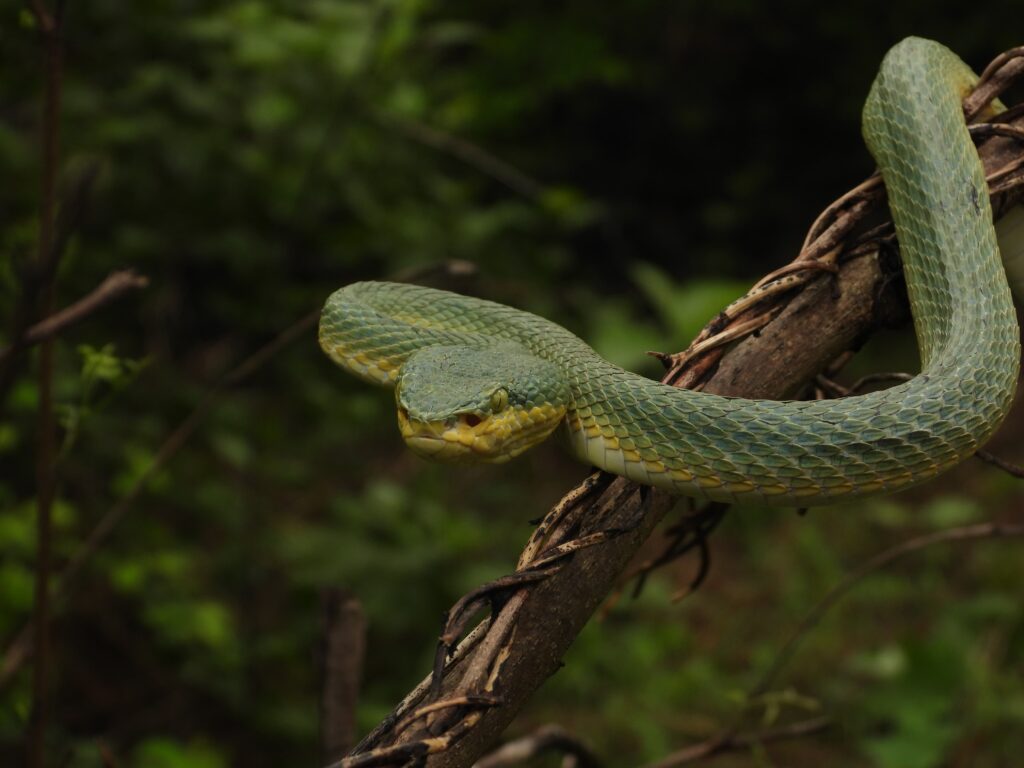
Description: The Bamboo Pit Viper is a venomous arboreal snake commonly found in forested areas. It has a cryptic coloration, blending in with its surroundings, and relies on ambush predation to capture its prey.
Also Read About: Wildlife Safaris in Core & Buffer of Kanha National Park
9.Common Kukri (Oligodon arnensis)
Common Name: Common Kukri
Degree of Venom: Mildly venomous
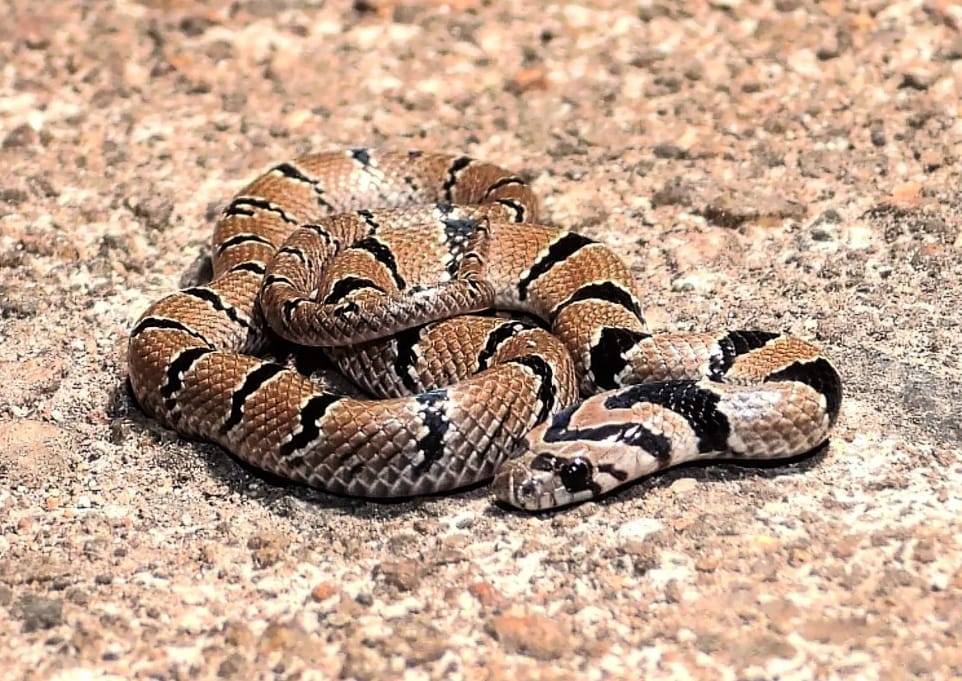
Description: The Common Kukri is a non-aggressive rear-fanged snake with a distinctive curved shape to its teeth. Its venom, while mildly toxic, is primarily used to incapacitate its prey, which includes small vertebrates and insects.
10. Red Sand Boa (Eryx johnii)
Common Name: Red Sand Boa
Degree of Venom: Non-venomous
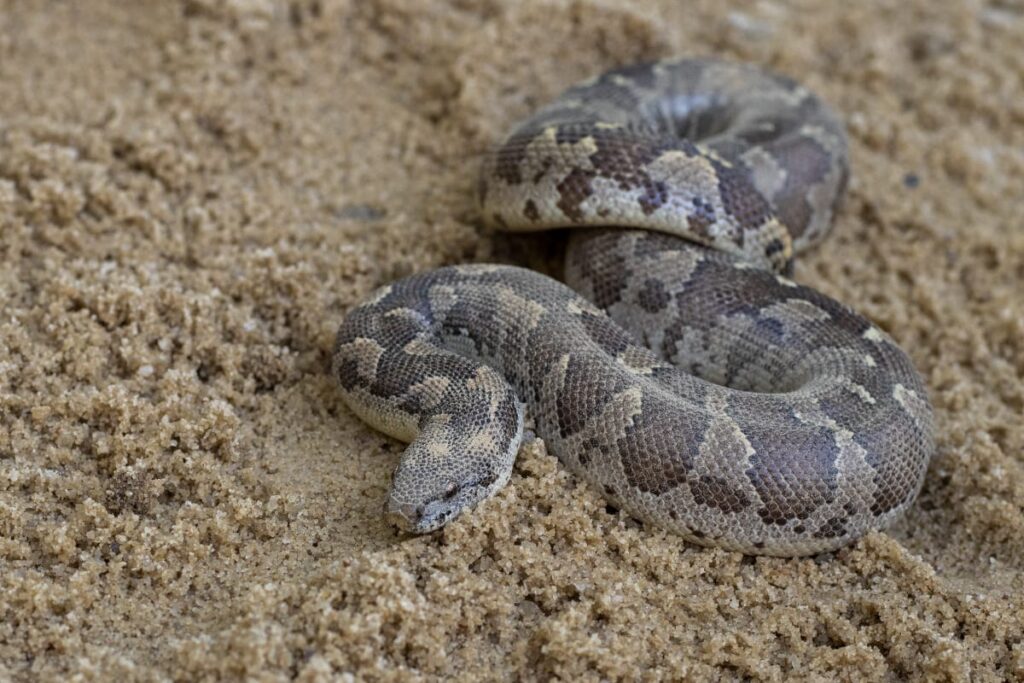
Description: The Red Sand Boa is a non-venomous, burrowing snake with a stout body and a blunt tail. It is known for its distinctive reddish-brown coloration and is often found in sandy or rocky habitats.
11. Checkered Keelback (Fowlea piscator)
Common Name: Checkered Keelback
Degree of Venom: Mildly venomous
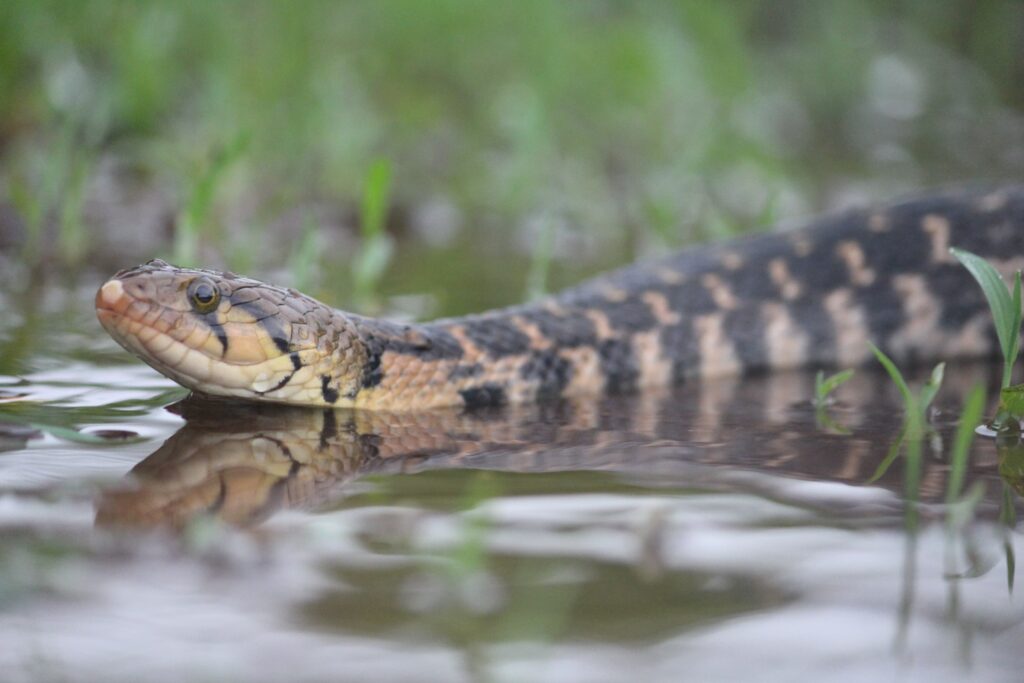
Description: The Checkered Keelback is a non-aggressive snake with a checkered pattern on its dorsal side. It is mildly venomous and primarily preys on amphibians and fish, often found near water bodies.
12. Buff Striped Keelback (Amphiesma stolatum)
Common Name: Buff Striped Keelback
Degree of Venom: Mildly venomous
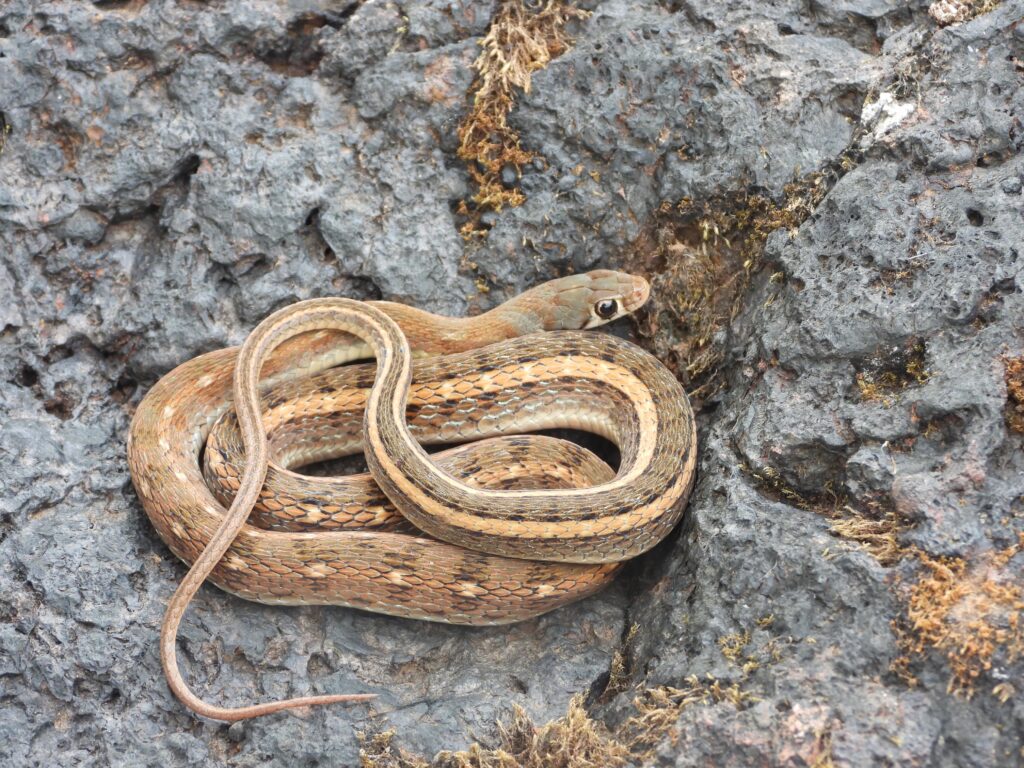
Description: The Buff Striped Keelback is a slender snake with buff-colored stripes running along its body. It is mildly venomous and feeds on small vertebrates and invertebrates found in wetland habitats.
13. Bronzebacked Tree Snake (Dendrelaphis tristis)
Common Name: Bronzebacked Tree Snake
Degree of Venom: Non-venomous
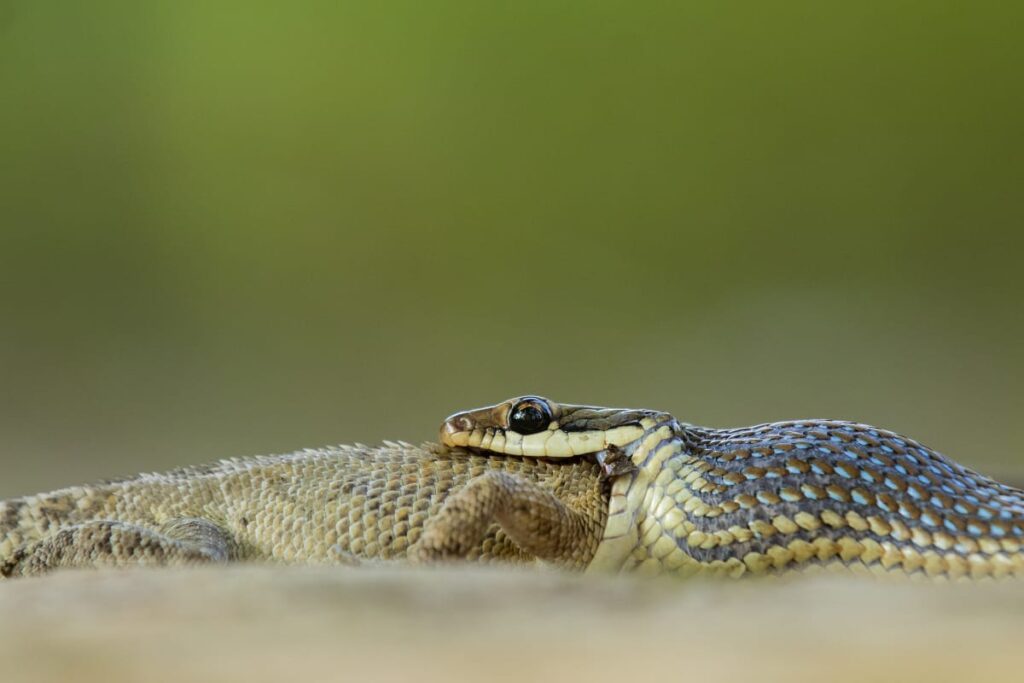
Description: The Bronzebacked Tree Snake is a slender and agile arboreal snake with a bronze-colored back and a white underside. It is often found in trees and bushes in forested areas, preying on small vertebrates and insects.
14. Common Cat Snake (Boiga trigonata)
Common Name: Common Cat Snake
Degree of Venom: Mildly venomous
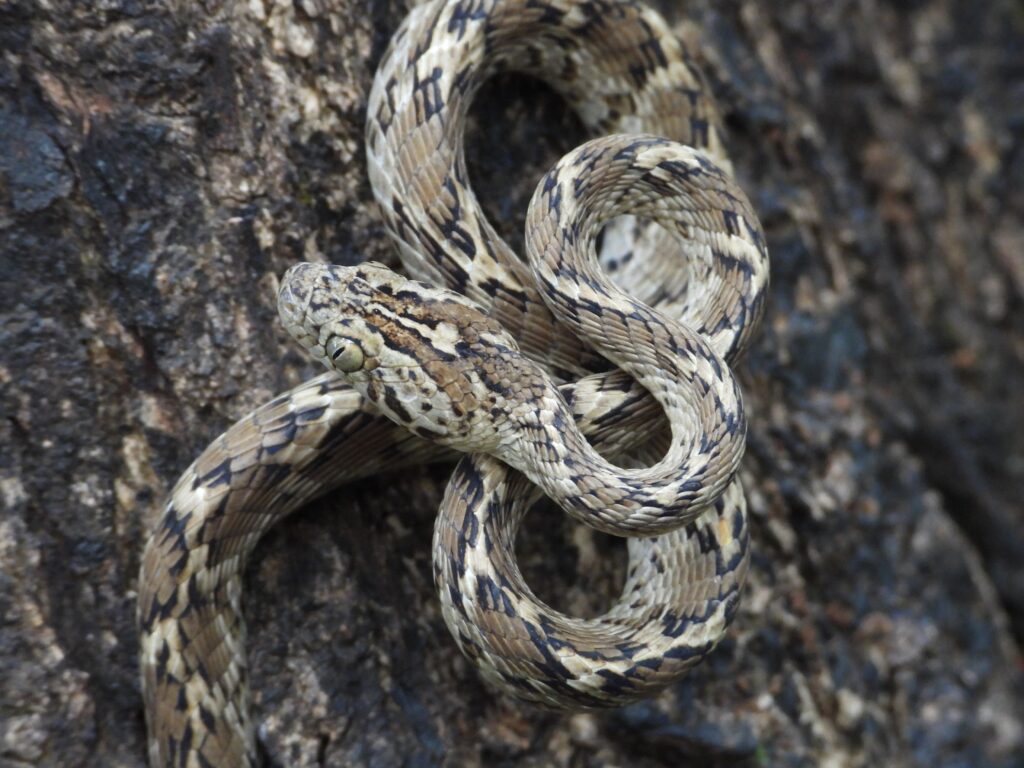
Description: The Common Cat Snake is a nocturnal snake with a slender body and large eyes. It is often found near human habitation and feeds on rodents and other small mammals, using its mildly venomous bite to subdue prey.
15. Indian Rat Snake (Ptyas mucosa)
Common Name: Indian Rat Snake
Degree of Venom: Non-venomous
Description: The Indian Rat Snake is a large and non-venomous snake with a slender body and a pointed snout. It is commonly found in a variety of habitats, including forests, grasslands, and agricultural areas, where it preys on rodents and birds.
16. Common Wolf Snake (Lycodon aulicus)
Common Name: Common Wolf Snake
Degree of Venom: Non-venomous
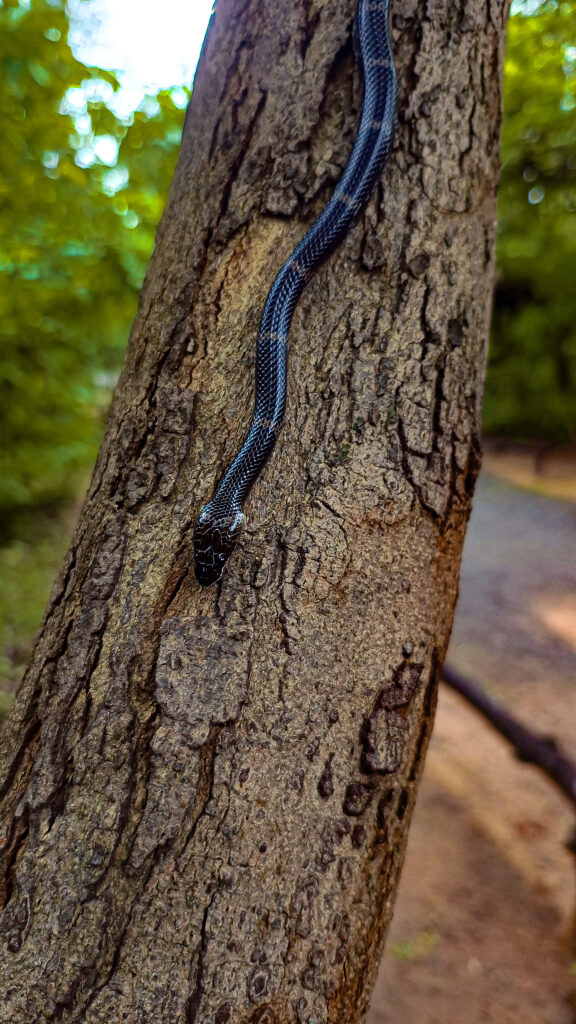
Description: The Common Wolf Snake is a nocturnal and non-venomous snake with a slender body and smooth scales. It is often found in human dominated areas and agricultural fields, where it preys on small reptiles and amphibians.
SNAKES AND THEIR BEHAVIOUR
In general, snakes exhibit a wide range of behaviors, from solitary hunters to communal baskers, and from ambush predators to active foragers. Their behavior is often influenced by factors such as habitat, prey availability, and reproductive cycles. While some species are known for their aggressive defense mechanisms, such as venomous strikes or bluffing displays, others prefer to retreat and avoid confrontation.
WHAT IS OPHIDIOPHOBIA?
The fear of snakes, known as ophidiophobia, is one of the most common phobias worldwide and is deeply rooted in human evolution. This fear likely stems from our ancestors’ encounters with venomous snakes in their natural environments, where survival depended on quickly identifying and avoiding potential threats. Despite their fearsome reputation, snakes play crucial ecological roles as predators, prey, and ecosystem engineers, contributing to biodiversity and maintaining ecological balance.
SNAKES WORLDWIDE
Globally, there are approximately 3,600 species of snakes distributed across diverse habitats, from tropical rainforests to arid deserts.
In India has over 300 species of snakes. Globally, the Inland Taipan (Oxyuranus microlepidotus) holds the title of the world’s most venomous snake, with venom capable of causing rapid paralysis and death. The Reticulated Python (Python reticulatus) is recognized as the world’s longest snake species, reaching lengths of over 20 feet.
On the other end of the scale, the Barbados Threadsnake (Leptotyphlops carlae) holds the title of the world’s smallest snake, with adults averaging less than 4 inches in length. As for speed, the Black Mamba (Dendroaspis polylepis) is often regarded as one of the fastest snake species, capable of reaching speeds of up to 12 miles per hour when threatened.
These remarkable creatures continue to intrigue and inspire awe, reminding us of the intricate interplay between nature, human perception, and the enduring mysteries of the natural world.
If you’re visiting Kanha to explore its wildlife, including its variety of snakes, consider staying at Kanha Earth Lodge. Our resort in Kanha provides a comfortable and immersive experience, making your wildlife adventure even more special.
References:
1. Shine, Richard. “Ecology of snakes: the behavior, ecology, and evolution of snakes.” John Hopkins University Press, 1991.
2. Greene, Harry W. “Snakes: The Evolution of Mystery in Nature.” University of California Press, 1997.
3. Campbell, Jonathan A., and Edmund D. Brodie Jr. “Biology of the pit vipers.” Texas A&M University Press, 2015.
4. Mattison, Chris. “The New Encyclopedia of Snakes.” Princeton University Press, 2007.
5. Mehrtens, John M. “Living snakes of the world in color.” Sterling Publishing Company, 1987.
6. Murphy, John C., and Robert W. Henderson. “Tales of Giant Snakes: A Historical Natural History of Anacondas and Pythons.” Krieger Publishing Company, 1997.
7. O’Shea, Mark. “Venomous Snakes of the World.” Princeton University Press, 2018.
8. Greene, Harry W. “Snakes: the evolution of mystery in nature.” University of California Press, 1997.
9. Campbell, Jonathan A., and Edmund D. Brodie Jr. “Biology of the pit vipers.” Texas A&M University Press, 2015.
10. Savage, Jay M. “The Amphibians and Reptiles of Costa Rica: A Herpetofauna between Two Continents, between Two Seas.” University of Chicago Press, 2002.
Written by Shashank Arya, Naturalist at Pugdundee Safaris

